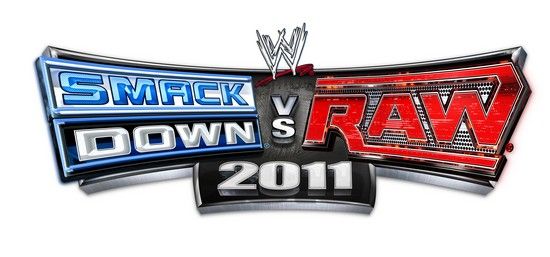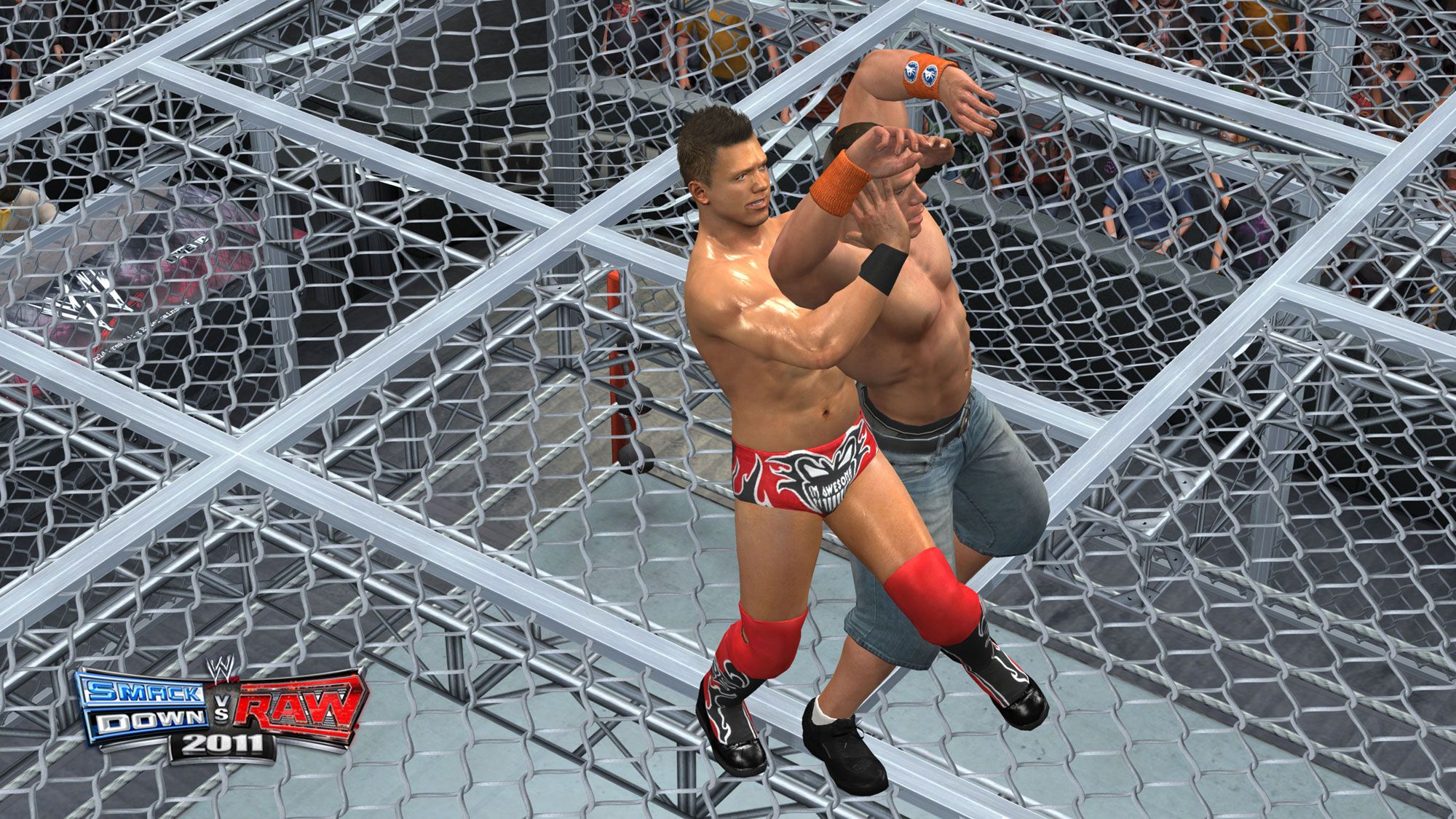For the past couple of years, fans of WWE haven't been seeing eye-to-eye with the previous releases of THQ's Smackdown vs. Raw series – I myself am one of those fans. Clunky controls, redundant issues like the targeting system, and a few other thorns on the side that made the game's entertainment factor inconsistent were the culprits that rendered the game's overall value mediocre. When you've played unforgettable classics like Wresltemania 2000 and No Mercy for the Nintendo 64, it's pretty hard to find something nowadays that fair against it, considering the gargantuan leap in technology that consoles have undergone. While many of us have perpetuated the thought and anticipation of something more concise (with regards to both look and feel) in the WWE franchise, we haven't really been introduced to anything, recently, that has given us that “wow” factor. All that, however, has changed with THQ's upcoming Smackdown vs. Raw 2011 – a game that THQ has clearly molded from the wants and needs of the WWE community.
On a year-to-year basis, when we see a franchise make their annual rounds, we tend to see small changes that affect the game's gameplay. The majority of time, you'll see some minor tweaks in gameplay mechanics – such as controls – that alleviate the previous issues that weren't popular amongst the gaming community – a cycle that becomes eternalized per annum. With Smackdown vs. Raw 2011, it seems THQ has completely thrown away that idea of “updating” the game, and has evolved it in its entirety, leaving familiar foundations to those who have followed the series habitually throughout the years.
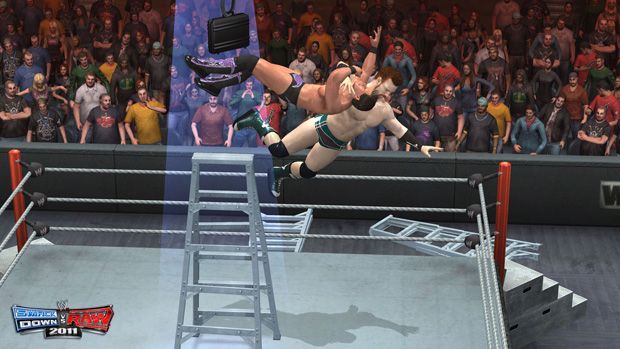 Visually, Smackdown vs. Raw 2011 is amazing. Usually, when critics glamorize a game's graphics engine, they tend to side with the more traditional – and more popular – tripple-A games. It's a rare occasion when we see publications praise sports games for their visual prowess. This time around, I'm going to do the opposite. Smackdown vs. Raw 2011 has some of the best character models that I have seen this generation. When I first saw Undertaker making his way to the ring via the dramatic entrance of his, I was, literally, astonished. Not only did the lighting and textures improve to enhance the game's realism, but the presence of the character was actually felt. It didn't feel as if Undertaker – or the rest of the roster – was a concoction of polygons programmed to do what he does on-screen; they felt natural. Their muscles flexed and tensed in a more realistic manner adding more depth to the game's realism, something that I've only seen in this game. Wrestlers now display pain and fatigue when they're unmercifully beaten down, which, again, adds to the realistic atmosphere of the characters.When this is added with the fluid motion of character movements, you have what we here at DualShockers like to call “sexy.”
Visually, Smackdown vs. Raw 2011 is amazing. Usually, when critics glamorize a game's graphics engine, they tend to side with the more traditional – and more popular – tripple-A games. It's a rare occasion when we see publications praise sports games for their visual prowess. This time around, I'm going to do the opposite. Smackdown vs. Raw 2011 has some of the best character models that I have seen this generation. When I first saw Undertaker making his way to the ring via the dramatic entrance of his, I was, literally, astonished. Not only did the lighting and textures improve to enhance the game's realism, but the presence of the character was actually felt. It didn't feel as if Undertaker – or the rest of the roster – was a concoction of polygons programmed to do what he does on-screen; they felt natural. Their muscles flexed and tensed in a more realistic manner adding more depth to the game's realism, something that I've only seen in this game. Wrestlers now display pain and fatigue when they're unmercifully beaten down, which, again, adds to the realistic atmosphere of the characters.When this is added with the fluid motion of character movements, you have what we here at DualShockers like to call “sexy.”
But visuals and a smooth character dynamism aren't the only ingredients needed to make a chunky bowl of Magnificent Soup. With the aforementioned qualities, controls play a huge role; and if you're familiar with the controls of the previous SvR games, you'll know that this wasn't one of their strong perks. Thankfully, the control system has been reworked to follow the evolution of the entire game. Characters are much more responsive to inputs, and the controls feel much smoother, compared to the cumbersome atrocity that I've experienced in the past. Some of the buttons have been moved around to simplify the execution of attacks, grappling, and moves; something I truly applaud THQ for doing as it makes the climate of the game much more malleable for both veterans of the franchise, and newcomers.
Aside from the aesthetic remodeling that took place with the game's facade, some internal changes were also done to provide a much richer and more genuine feel to this year's SvR. One of the the noticeable alterations is that of the new physics system that THQ has worked in (Object Interactions). Players will now be able to run up ladders that are leaning against the ropes, there's new directional grapple throws (which controls which direction to slam/throw an opponent depending on the directional input you choose), and you'll quickly notice that tables will now break up differently (i.e. more dynamic). If you bodyslam an opponent on the edge of a table, it'll be much different in how the table breaks apart when, for example, you suplex them through the middle of the table. If your opponent is outside the ring and there's a ladder leading against the rope, you'll be able to run up that ladder and perform a suicidal dive move that would probably kill you in real life. But we all know that wrestlers are made of steel, gelatin and spandex, so they can survive these death-defying campaigns of mutilation.
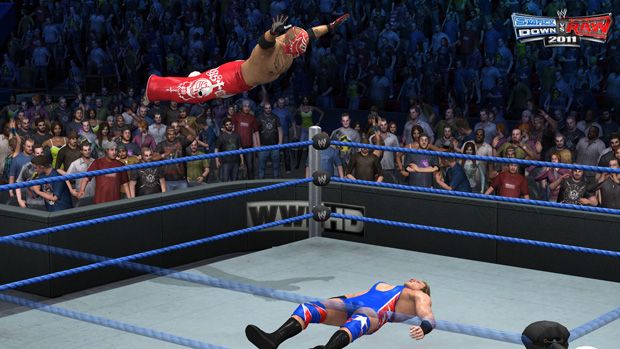 Another well-deserved pat on the head goes to THQ for fixing up the “Hell in the Cell” mode. In previous games, we can all look back and have nightmarish moments at how ridiculous the cage to ring ratio was. There wasn't enough room between the two to allow a true rumble outside. When you factor in the behemoth sizes of these barbaric athletes to the limited size we were given in the past, it was as if THQ was purposely playing a practical joke. All that was missing from this was the Benny Hill theme. At that juncture, “Hell in the Cell” was nothing but an understatement.
Another well-deserved pat on the head goes to THQ for fixing up the “Hell in the Cell” mode. In previous games, we can all look back and have nightmarish moments at how ridiculous the cage to ring ratio was. There wasn't enough room between the two to allow a true rumble outside. When you factor in the behemoth sizes of these barbaric athletes to the limited size we were given in the past, it was as if THQ was purposely playing a practical joke. All that was missing from this was the Benny Hill theme. At that juncture, “Hell in the Cell” was nothing but an understatement.
However, after years of vocal nourishments from the community, THQ decided that maybe things needed to be a tad more sensible regarding scale. SvR 2011 reconstructs the “Hell in the Cell” mode from the ground up. For one, there is much more room inside the cage which, amazingly, allows for the addition of contractual grapples in the cage space. There are no physical doors inside the cage space, os in order to get outside the ring to climb up, the player must “break” their way out by executing “special moves” on their opponent against the cage. Once the cage is open, you can imagine the godforsaken things that go on (if you've been following WWE, that is).
Exhibition modes now come prepackaged with story elements (Exhibition Plus). What this means is that things can happen to you at any given time (e.g. getting hit while entering the ring while your dramatic music permeates the arena, and extra beat down after a match is done, random interferences during a match, etc.) . This is reflected by the relationships you maintain throughout the game. This, my friends, goes hand-in-hand with the newly introduced WWE Universe – which will track just about everything you do in exhibition mode. The game will build match cards, partnerships, rivalries, etc. You'll be able to make changes to the matches for events (which includes Pay Per View events), roster, just about everything. If you're a lazy bastard, or are just too scared of getting your ass kicked by Randy Orton, you can opt to just simulating the matches, rather than playing them.
Ideally, the WWE Universe mode builds a catalog of beefy wrestlers all aiming for the same thing: rank changes, current champions, number one contender spots, etc. If I could sum up WWE Universe, it would be you, the player, having absolute control of wake happens in the WWE universe you're in – and addition, I believe, players will appreciate.
Road to Wrestlemania makes its return as well, alongside the plethora of additions that have been implemented. Unlike previous installments in the franchise, this year's Road to Wrestlemania gets beefed up with tons of new things to increase the interaction of the player and WWE world outside the ring. For example, there are now additions of backstage elements. Players will now be able to participate in storylines outside their very own; you'll now have access to numerous rooms (the training room, green room, etc.) that will be filled with WWE stars for you to interact with. During this humble moment of exploration, backstage fights will, of course, break out as well. You can't expect to live a wrestler's career and think you'll be serving up crumpets and chamomile tea with your rivals.
On occasion, you'll have stars approach you and talk smack. Some will try to give you some advice, while others will get in your face and try to intimidate you with either their physical stature, or their unforgivable gingivitis breath. The beauty of it all is that you won't have to sit there and listen to them preach about how awesome they are. This year's Road to Wrestlemania will give you the almighty freedom of deciding what actions to take against these kind of encounters. You can ignore the confrontation and walk away, or you can punch the blabbering wrestler in the face. Of course, each action comes with a reaction. Depending on how you decide to handle the situation, any action taken will determine the path of your story. It will decide whether or not the wrestler you decided to introduce your fist to will be one of the merry people to interfere with your match.
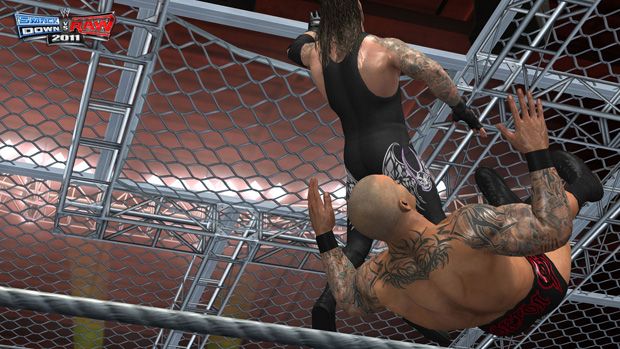 I think one of my favorite improvements to the game has to be the Character Customization mode, which has received quite a facelift. Aside from the repetitive elements seen in previous wrestling games, SvR 2011 incorporates a couple of new features that make customizing your wrestler much less of a chore, and more of a “fun thing” to do. Superstar points, which are obtained by playing matches, are used to develop your character's attributes. Rather than sitting in front of you TV for hours on end while consuming large quantities of Keebler Fudge Cookies with absolutely zero milk and playing infinite matches to get attributes, you can now play an opponent and earn your Superstar points at a much more satisfying pace.
I think one of my favorite improvements to the game has to be the Character Customization mode, which has received quite a facelift. Aside from the repetitive elements seen in previous wrestling games, SvR 2011 incorporates a couple of new features that make customizing your wrestler much less of a chore, and more of a “fun thing” to do. Superstar points, which are obtained by playing matches, are used to develop your character's attributes. Rather than sitting in front of you TV for hours on end while consuming large quantities of Keebler Fudge Cookies with absolutely zero milk and playing infinite matches to get attributes, you can now play an opponent and earn your Superstar points at a much more satisfying pace.
For those of you who were fans of editing DLC, you'll be glad to know that community changes are now back. But the biggest addition of all to the character customization comes in the form of move lists. Players can now choose from over 130 moves – a dramatic increase from the 30 that was available last year.
SvR 2011 has come a long way when compared to the previous releases of the game in the past couple of years. The evolution that it has undergone is almost everything that fans of the franchise have been looking for. I say the word “almost” because not ever element of the game is perfect, as much as it is close to being. Minor issues like not being able to kick a ladder existed – something that I feel, with the new physics system, is very important. Sure, you're able to shake your opponent off the ladder; but to make it much more dramatic and realistic, I prefer to kick the ladder over and have my opponent slam onto the mat, or onto the rope (wherever he/she lands). The biggest annoyance to me, though, that made its way to this year's release is the targeting system. I'm not a fan of having to walk in close proximity of my opponent to switch my attack direction toward them. At times, this method is inefficient, especially when playing against three or more people in the same ring where the targeting assumes you want to attack the person you don't. I've always been a fan of button switching. Maybe, in future games, THQ can incorporate the use of a button plus the direction of an analog stick to better choose your target, rather than relying on the assumption of a directional mistake.
The sound was probably something else that, at the time, seemed to lack when considering everything else was so acute. The ambient noises of the crowd could have been upped a tad to give the feel that I was, in fact, wrestling in a large arena filled with hundreds/thousands of people.
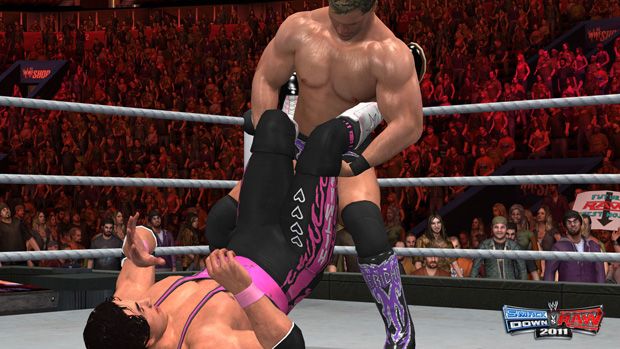 It's not to say that SvR 2011 isn't the gem that THQ made it out to be, because it definitely is. Although there are minor issues that I'm sure will be ironed out with future releases, one has to take into consideration that it truly feels as if the developers worked on this game from the ground up, working on things that the community of fans wanted to see redone and/or implemented, first and foremost. And given that they didn't get a chance to work on everything they wanted to implement, I sincerely will state that WWE Smackdown vs. Raw 2011 is one of the best wrestling games I've played in years. The fact that playing the game is no longer a burden due to inconsistencies in its design leaves more than enough room for sheer entertainment. It's been a while since a game – a wrestling one at that – put a smile on my face and instilled one of the enjoyable experiences I've had this generation. Anyone can quickly pick up the controls and have at it. It is a welcoming experience to newcomers, and a solid evolution to those who have followed the series since its inception.
It's not to say that SvR 2011 isn't the gem that THQ made it out to be, because it definitely is. Although there are minor issues that I'm sure will be ironed out with future releases, one has to take into consideration that it truly feels as if the developers worked on this game from the ground up, working on things that the community of fans wanted to see redone and/or implemented, first and foremost. And given that they didn't get a chance to work on everything they wanted to implement, I sincerely will state that WWE Smackdown vs. Raw 2011 is one of the best wrestling games I've played in years. The fact that playing the game is no longer a burden due to inconsistencies in its design leaves more than enough room for sheer entertainment. It's been a while since a game – a wrestling one at that – put a smile on my face and instilled one of the enjoyable experiences I've had this generation. Anyone can quickly pick up the controls and have at it. It is a welcoming experience to newcomers, and a solid evolution to those who have followed the series since its inception.
Just about everything that SvR 2011 does, it does extremely well. If you're under the impression that THQ doesn't listen to its community, SvR 2011 will genuinely disapprove that thought. Everything from its core has been revamped and redesigned to adjust to the community's response. You won't see everything that you want this time around, but it is definitely a step in the right direction for THQ. My opinion, aside from the ridiculously long impression I wrote: Get the game. It's, without a doubt, the best WWE game that I've played in the last ten years. It's fun, it's competitive, and it's what fans of the franchise have been waiting for. It's a WWE game done right.

